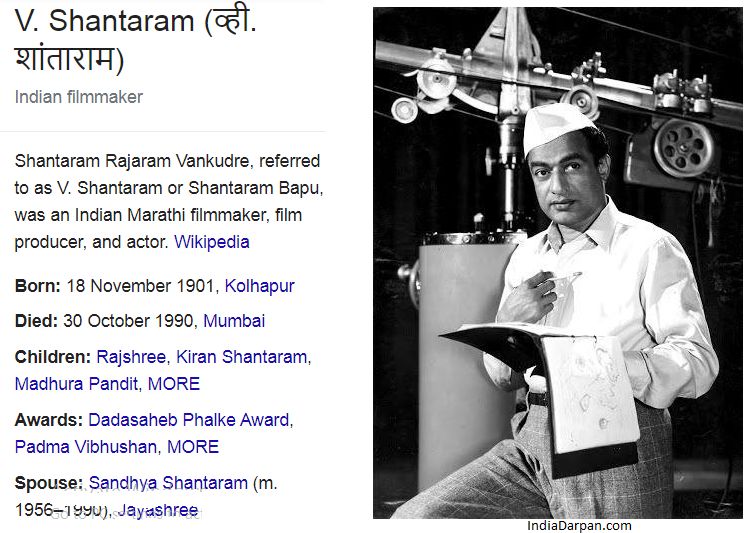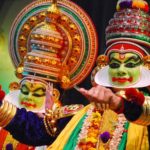- General
- Updated on September 15, 2020
V. Shantaram Biography : Life | Childrens | Awards | Death

Introduction
The man, the myth, the legend. These words are usually a part of an introductory speech which is more commonly used these days for people who have a legendary status. But being the one who made this phrase into being is a whole different deal. Shantaram was one of those guys. Known as the foundation of what the Indian film industry is today. He was, is and will remain a name that Bollywood would be renowned for. This is who that icon was. This is his story. This is Shantaram Rajaram Vankudre.
Birth and Education
Shantaram Rajaram Vankudre, more commonly known as Shantaram Bapu, V.Shantaram or Annasaheb was born on 18th November 1901 in Kolhapur, Kolhapur State of British India. Born into a Marathi family to a Jain Kasar Father and a Hindu mother, his childhood was pretty comfortable and he was pampered a lot. Even with the bad financial conditions of his family, he still was able to go to school but not willingly. He never had a knack for studies but he excelled in extracurricular activities. He gained a reputation of being a good mimic and was called a late for the reason to perform. Shantaram also had a massive love and interest in music. But later on, he got to realise at a theatre show that he couldn’t sing well and also didn’t a good sense of music which infuriated and disappointed him.Later on, he knew that his study isn’t doing much to him or the family so eventually a family friend acquired him a job at the railway workshop. There he worked hard until he met with an accident and squashed two of his fingers. He was married early at the age of 20 to Vimalabai who was merely 12 years old in 1921.
Family
Rajaram V. Shantaram was a man of the family. Not saying this because he had a vast family of 7 children and 3 wives but because he took care of each one of them equally.
Although Vemla had not consented to him marrying another woman, he still married Jayshree, the actress whom the first wife accepted and they lived happily for some time. All his marriages took place according to Hindu rituals.
Here is a list of his family members-
Wives:
-
Vemla Shantaram
-
Jayshree Shantaram
-
Sandhya Shantaram
Sons:
-
Prabhat Kumar
-
Kiran Shantaram
Daughters:
-
Saroj
-
Madhura
-
Charusheela
-
Rajshree
-
Tejashree
The three marriages
Shantaram Rajaram Vankudre married three women.
Vemlabai: the love of his life
Vemlabai was only 12 years old when V. Shantaram’s family tied the knot of love between the two in 1921. At that time, V. Shantaram was 20 years old. The wedding ceremony took place according to Hindu customs and rituals.
Since Vemla lived with her only family, a brother before marriage, he came to live with the couple after their marriage and lived with them until his death caused by tuberculosis. All his expenses were borne by V. Shantaram himself without any say in the amount of money he spent. The kind-hearted man never complained about anything.
Vemlabai bore 4 children to V. Shantaram namely the son Prabhat Kumar along with three daughters Saroj, Madhura and Charusheela.
They lived happily under one roof until the man of the house got another woman in the house after 20 years of happily living with his wife. This broke the lady in different ways giving her some mental breakdowns and loss of a husband’s love.
Jayshree: the actress who gave him blockbuster hits
Jayshree was the lady with whom Rajaram fell in love at work. He had done various movies with the same actress and then, one day, on October 22, 1941, got married to her and took her home. This had a bad effect on his first family but somehow they managed to live together because Vemla did not want to get separated from her husband.
Jayshree bore 3 kids to Shantaram namely a son Kiran Shantaram who is a former sheriff of Mumbai and had been a great film director and producer. Her other two daughters were Rajshree who is also a well-known actress who got married to a foreigner and started living in Los Angeles ever since and Tejashree about whom there is not much information.
Jayshree and Shantaram along with their family lived in the studio while Vemla and her family lived in their home every day the father used to give at least one hour of his day to his first family too. The children used to play all together and were being grown up together. In some way, Vemla had accepted Jayshree as Rajaram’s second wife. One day when her daughter asked her why she did not leave their father, Vemla said that she was uneducated and had no talents. She chose to wash clothes at her own house rather than in other people’s houses to earn a living for her 4 children. Vemla saved her children’s lives.
The whole family used to get packed into 2 cars while going out for vacations which shows how much harmony they had as a family.
One day, while shooting for a film with Sandhya, Rajaram got broke and needed more money for which he had asked both his wives to give the jewellery. He wanted to mortgage them for his next movie’s production and promised to return the jewellery as soon as the film gets launched but Jayshree refused because she had an inkling that Rajaram is having a thing with her own sister Sandhya while on the other hand, Vemla gave all her jewellery because all that she had belonged to her husband. Soon the couple got separated on 13 November 1956 and Rajaram married Sandhya in the same year on December 22.
Sandhya: the soulful lady
After their marriage, Sandhya and Rajaram could not have any children because he recently had an operation which resulted in him being not at all production to bear any child.
Sandhya is a nice lady, unlike what Jayshree had told had about her, a gold-digger. Sandhya said that all Rajaram’s children were hers and she did not need any more.
She lived a simple life of a married woman who always wore white saree paired beautifully with green bangles and complimentary red bindi along with mangal sutra around her neck.
Sandhya did various movies with Rajaram and became one of the most popular actresses of that time.
She is the one who served food at the annaprashan of Madhura’s son because Vemla had died after V. Shantaram’s death.
Sandhya Shantaram lives with Vemla’s children today under their care.
Rajaram among Women
As famous in women, as he was for his looks, Rajaram got controversy for an incident. The director was very particular with his work so he used to check every actress’s makeup before shooting. Once while he went inside the vanity van of an actress, he found her completely naked. Everyone was wondering what he would do and thought that he would try to misuse the opportunity but rather, he threw some papers at the actress and told her to get dressed in 15 while he checked on other actresses.
Another incident took place when an actress got influenced by his looks and style and tried to seduce him. She locked him up in a vanity van and started removing her clothes when Rajaram said: “A woman looks her best in proper attire.” This made him a legend among women.
Career
With a career ranging a span of 7 decades, Shantaram left a mark on the Indian film industry. Being one of the most beloved directors of the early days of Bollywood, Shantaram was one of the few who really knew how to own and manipulate the art of direction. He was also known by the name Annasaheb in the industry. Shantaram was the one who used his power of bringing pictures to life to bring social change. His aspects of direction spread through advocating humanism on one side and exposing injustice and bigotry on the other. With his talents not only limited to acting and directing, but he also had a knack for music. Being known to have “Ghost Written” many of the B-Town’s bangers of the time, Shantaram was a heavy and active influence over music of that time. Shantaram’s talent and abilities also took the eyes of the king of comedy himself, Charlie Chaplin. Chaplin watched his 1939 Marathi melodrama called Manoos and apparently liked it a lot, for which he praised Shantaram. But where did it all began for Annasaheb?
Beginning his career with running errands for the Maharashtra Film Co. in Kolhapur. After all the initial struggle, Shantaram got his first break as an actor in 1921 with Surekha Haran in which he played the role of Lord Krishna himself. Surekha Haran was a silent film directed by Baburao Painter, the man who owned the Maharashtra Film Co. Then along came two more films where he starred as an actor before his directing debut which included, Sinhagad in 1923 and Savkari Pash in 1925.
Then came the directorial debut of Annasaheb which will make him a legend in the film industry. In 1927, Shantaram tried his hands first on the Marathi side of films where he made Nana Palkar. Nana Palkar was a historical silent film which followed the premise of Maharaja Shivaji’s Senapati, Nana Palkar. Shantaram’s debut made a huge impact on the Marathi cinema and became a pioneer. After his first release, Shantaram founded his own production house, Prabhat Film Co. This Production house produced a series of 19 Films with Shantaram as the director. The films included biggies like Manoos, Padosi, Ayodhyacha Raja, Sinhagad, Udaykal, Rani Saheba etc. In fact, Shantaram’s Ayodhyacha Raja became the first Marathi language film in 1932. Then after 19 films under his belt, he left Prabhat Film Co. to form “Rajkamal Kalamandir” in Mumbai, which later became one of the most sophisticated studios of the country.
In Rajkamal, he made a total number of 22 movies which included hits like Stree, Pinjra, Shakuntala, Amar Bhopali etc. During his time in Rajkamal, he debuted many to be superstars such as his own daughter Rajshree in the movie Pattharon Ne Geet Gaya alongside Jeetendra whose debut it also was. Then, later on, he also debuted his second wife’s niece, Ranjana Deshmukh in the Marathi Film Industry with the film, Chandranachi Choli Ang Ang Jaali in the year, 1975. Later on, Ranjana dominated the Marathi Film Industry in the ’70s and ’80s. After his death in October of 1990, an autobiography named Shantaram was released in both Hindi and Marathi.
Works
Initially, as an actor, V. Shantaram had acted in various super hit movies including Surekha Haran (1921), Sinhagad (1923), Savkari Pash (1925), Stri (1961), Parchhain (1952) and Do Ankhen Barah Haath (1957)
Later, he produced many gems and hits which included Banwasi (1948), Sehra (1963), Geet Gaya Patharon Ne (1964),
Ladki Sahyadri Ki (1966), Jal Bin Machhli Nritya Bin Bijli (1971), Raja, Rani Ko Chahiye Pasina (1978) and Jhanjhaar (1987)
Earlier V. Shantaram directed films from his direction house, Maharashtra Film Company. Those films included Netaji Palkar (1927), Prabhat Film Company, Gopal Krishna (1929), Udaykal (1930), Rani Saheba (1930), Khooni Khanjar (1930), Chandrasena (1931), Maya Machindra (1932), Agnikankan (1932), Ayodhyecha Raja (1932), Sinhagad (1933), Sairandhri (1933), Amrit Manthan (1934), Dharmatma (1935), Chandrasena (1935), Amar Jyoti (1936), Duniya Na Mane (1937), Kunku (1937), Manoos (1939), Aadmi (1939) and Padosi (1941)
From Rajkamal Kalamandir production house, Shantaram made iconic films which included Shakuntala (1943), Bhagwan Das Patel (1997), Dr Kotnis Ki Amar Kahani (1946), Lokshahir Ram Joshi (1947), Apna Desh (1949), Dahej (1950), Amar Bhoopali (1951), Teen Batti Char Raasta (1953), Surang (1953), Subah Ka Tara (1954), Jhanak Jhanak Payal Baaje (1955), Toofan Aur Diya (1956), Do Aankhen Barah Haath (1957), Navrang (1959), Stree (1961), Sehra (1963), Geet Gaya, Patharon Ne (1964), Ladki Sahyadri Ki (1966), Boond Jo Ban Gayee Moti (1967), Jal Bin Machhli Nritya Bin Bijli (1971), Pinjra (1973) and Jhanjhaar (1987).
Awards and Honours
In the name of Awards and Honours, Annasaheb both had them and literally “Had” them. It all started in 1955 with Shantaram’s first award of All India Certificate of Merit for Best Feature Film for his film Jhanak Jhanak Payal Baaje. Then in 1955, he received another award called President’s Silver Medal for Best Feature Film in Hindi for Jhanak Jhanak Payal Baaje.
Then came the barrage of awards for him. In 1957 alone, he received – President’s Gold Medal for the All India Best Feature Film for Do Aankhen Barah Haath, President’s Silver Medal for Best Feature Film in Hindi also for Do Aankhen Barah Haath and a Filmfare Award for Best Director for Jhanak Jhanak Payal Baaje. These awards made his already star-studded name rock-solid in the film industry. Then in 1958, he became Mr Worldwide when he got the invite for the International Film Festival in Berlin where he won the OCIC Award for Do Aankhen Barah Haath and The Silver Bear (Special Prize) also for Do Aankhen Barah Haath. Then in 1985, Shantaram received the honour of Dadasaheb Phalke Award.
After his death, in 1992 he was honoured with a Padma Bhushan award posthumously.
The Central Government and Maharashtra State Government constituted an award in his honour called the V. Shantaram Award. The V. Shantaram Motion Picture Scientific Research and Cultural Foundation was also established in 1993 in his memory which offers various awards to film-makers. The award is presented annually on 18 November. On 17 November 2001, The India Post decided to dedicate and released a postage stamp in Shantaram’s honour.
Death
In 1990, on October 30, the Marathi legend was received in heaven by the way of death.
V Shantaram was 88 years old when he still used to take rounds to the studio every day. One day, he fell and his hip bone got cracked.
Immediately the director was admitted into a hospital in Mumbai, Maharashtra but to no avail. He got weaker and weaker each day. One day, he stopped eating as well.
Sandhya used to take care of him even in his last days. One day, he vomited and the lady collected all that in her hands. This made everyone wonder about true love and efforts.
Soon he passed away and a large gathering was seen at his funeral.
Jayshree too attended the funeral and lived the life of a widow ever since. Everyone realised how much she loved him and divorce papers never really got them separated by a heart.
After his death, Velma got bedridden and passed away in 1996 leaving Sandhya behind to take care of her children.
Rajaram might have died but he had left enough for his children to survive for decades. The whole expenses of Vemla and her children were borne by the Rajkamal Studio.
Conclusion
Late Shantaram Rajaram Vantukde was a legend who, even after his death, lives in the hearts of many. Not only was he a man of kindness, but also had various other talents. He was a magnet for women but he believed that a woman looks her best when in proper attire and not when she is naked.
Rajaram swept away various awards for his works and gave us the most memorable movies in his time.
What everyone must learn from him is the way he tackled his wives and earned their love all together. He was a family man who loved his family so much.
Shantaram was not just a man, he was a brand, he was a legend.
Join the discussion
Related Articles
There are no results matching your search.
ResetTrending Articles


- Festivals
- Updated on July 15, 2024


- General
- Updated on July 8, 2024


- General
- Updated on June 25, 2024


- General
- Updated on June 18, 2024


- Education
- Updated on June 7, 2024


- General
- Updated on May 29, 2024


- Fashion
- Updated on May 24, 2024


- General
- Updated on March 19, 2024


- General
- Updated on March 18, 2024


- Festivals
- Updated on March 15, 2024
There are no results matching your search.
Reset


